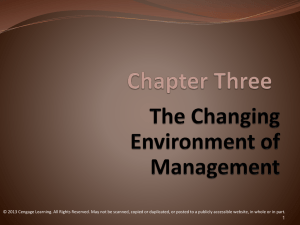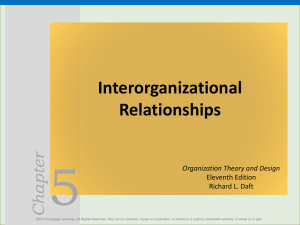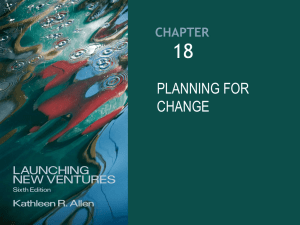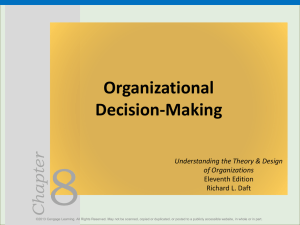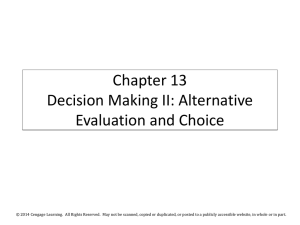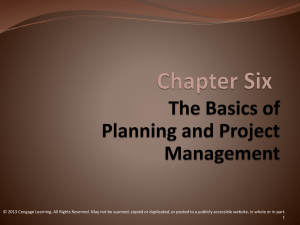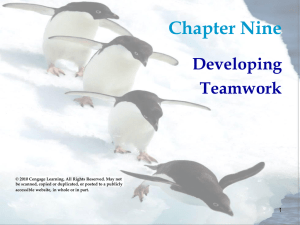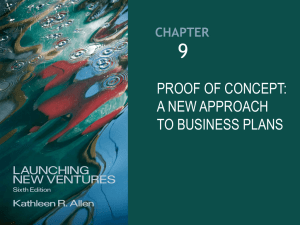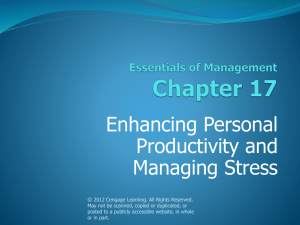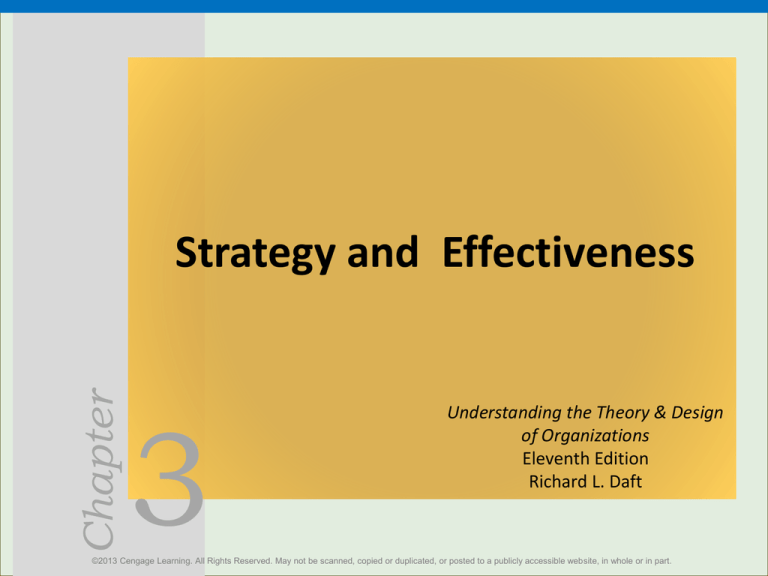
Chapter
Strategy and Effectiveness
3
Understanding the Theory & Design
of Organizations
Eleventh Edition
Richard L. Daft
©2013 Cengage Learning. All Rights Reserved. May not be scanned, copied or duplicated, or posted to a publicly accessible website, in whole or in part.
Strategy Direction and
Organization Design
Organizational
goal - a desired
state of affairs
that an
organization
attempts to reach
2
©2013 Cengage Learning. All Rights Reserved. May not be scanned, copied or duplicated, or posted to a publicly accessible website, in whole or in part.
Organizational Purpose
Strategic intent - organization’s energies and resources are
directed toward a focused, unifying, and compelling goal
Operating Goals
• Overall Performance
• Resources
• Market
• Employee Development
• Innovation and Change
• Productivity
•Mission
•Competitive Advantage
•Core Competence
3
©2013 Cengage Learning. All Rights Reserved. May not be scanned, copied or duplicated, or posted to a publicly accessible website, in whole or in part.
Mission Statement for
Machias Savings Bank
4
©2013 Cengage Learning. All Rights Reserved. May not be scanned, copied or duplicated, or posted to a publicly accessible website, in whole or in part.
Organizational Operating Goals
5
©2013 Cengage Learning. All Rights Reserved. May not be scanned, copied or duplicated, or posted to a publicly accessible website, in whole or in part.
The Importance of Goals
6
©2013 Cengage Learning. All Rights Reserved. May not be scanned, copied or duplicated, or posted to a publicly accessible website, in whole or in part.
Selecting Strategy and Design
• A strategy is a plan for interacting with the
competitive environment
• Managers must select specific strategy design
• Models exist to aid in formulating strategy:
– Porter’s Five Forces
– Miles and Snow’s Strategy Typology
7
©2013 Cengage Learning. All Rights Reserved. May not be scanned, copied or duplicated, or posted to a publicly accessible website, in whole or in part.
Porter’s Competitive Strategies
Differentiation strategy – to distinguish products or
services from others in the industry
Low-Cost Leadership – increase market share by
keeping costs low compared to competitors
Organizations may choose to focus broad or narrow in
reaching multiple markets.
8
©2013 Cengage Learning. All Rights Reserved. May not be scanned, copied or duplicated, or posted to a publicly accessible website, in whole or in part.
Porter’s Competitive Strategies
9
©2013 Cengage Learning. All Rights Reserved. May not be scanned, copied or duplicated, or posted to a publicly accessible website, in whole or in part.
Miles and Snow’s
Strategy Typology
Managers should seek to formulate strategy that matches the demands
of the external environment
• Prospector
– Learning orientation; flexible, fluid, decentralized structure
– Values creativity, risk-taking, and innovation
• Defender
– Efficiency orientation; centralized authority and tight cost control
– Emphasis on production efficiency, low overhead
• Analyzer
– Balances efficiency and learning; tight cost control with flexibility and
adaptability
– Emphasis on creativity, research, risk-taking for innovation
• Reactor
– No clear organizational approach; design characteristics may shift
abruptly depending on current needs
10
©2013 Cengage Learning. All Rights Reserved. May not be scanned, copied or duplicated, or posted to a publicly accessible website, in whole or in part.
How Strategy Affects
Organization Design
Strategy impacts internal
organization characteristics
Managers must design the
organization to support the firm’s
competitive strategy
11
©2013 Cengage Learning. All Rights Reserved. May not be scanned, copied or duplicated, or posted to a publicly accessible website, in whole or in part.
Organization
Design
Outcomes of
Strategy
©2013 Cengage Learning. All Rights Reserved. May not be scanned, copied or duplicated, or posted to a publicly accessible website, in whole or in part.
Contingency Factors
Affecting Organization Design
13
©2013 Cengage Learning. All Rights Reserved. May not be scanned, copied or duplicated, or posted to a publicly accessible website, in whole or in part.
Assessing Organizational
Effectiveness
Effectiveness takes into consideration a range of
variables at both the organizational and departmental
levels.
Efficiency relates to the working of the organization and
amount of resources used to produce output.
Measuring Effectiveness:
→ The Goal Approach
→ The Resource-Based Approach
→ The Internal Process Approach
→ The Strategic Constituents Approach
14
©2013 Cengage Learning. All Rights Reserved. May not be scanned, copied or duplicated, or posted to a publicly accessible website, in whole or in part.
Indicators of Organizational
Effectiveness
15
©2013 Cengage Learning. All Rights Reserved. May not be scanned, copied or duplicated, or posted to a publicly accessible website, in whole or in part.
Approaches to Measuring
Organizational Effectiveness
16
©2013 Cengage Learning. All Rights Reserved. May not be scanned, copied or duplicated, or posted to a publicly accessible website, in whole or in part.
An Integrated Effectiveness Model
• Competing values model tries to balance
concern with various parts of the organization
• The human relations emphasis incorporates
the values of an internal focus and flexible
structure
17
©2013 Cengage Learning. All Rights Reserved. May not be scanned, copied or duplicated, or posted to a publicly accessible website, in whole or in part.
Four Approaches to
Effectiveness Values
18
©2013 Cengage Learning. All Rights Reserved. May not be scanned, copied or duplicated, or posted to a publicly accessible website, in whole or in part.
Effectiveness Values for
Two Organizations
19
©2013 Cengage Learning. All Rights Reserved. May not be scanned, copied or duplicated, or posted to a publicly accessible website, in whole or in part.
Design Essentials
Organization exist for a purpose
Strategic intent includes competitive advantage and
core competence
Strategies may include many techniques
There are models to aid in the development of
strategy
Organizational effectiveness must be assessed
No approach is suitable for every organization
20
©2013 Cengage Learning. All Rights Reserved. May not be scanned, copied or duplicated, or posted to a publicly accessible website, in whole or in part.


